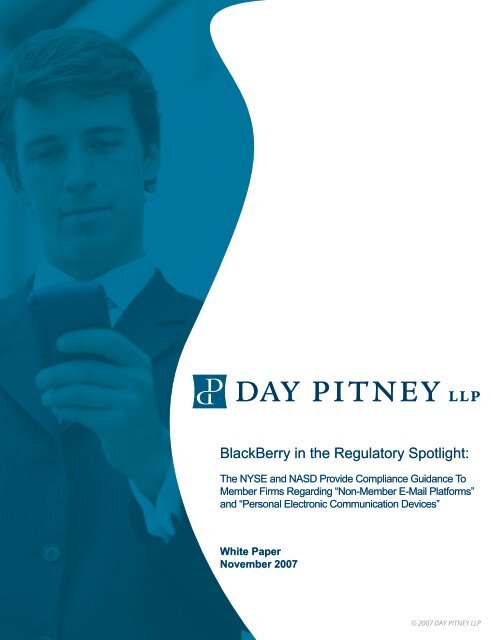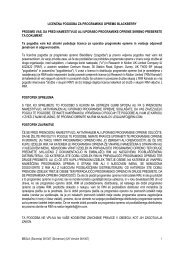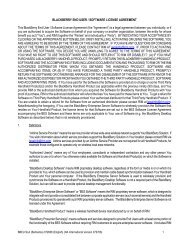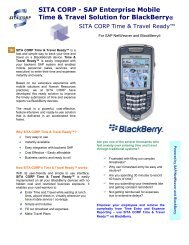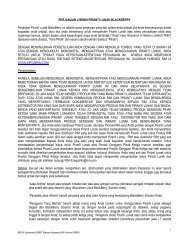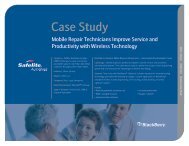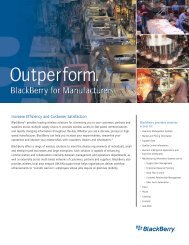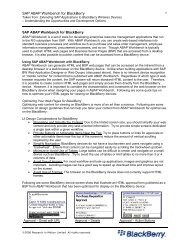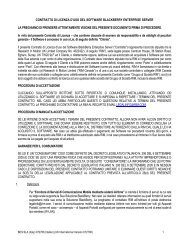BlackBerry in the Regulatory Spotlight:
BlackBerry in the Regulatory Spotlight:
BlackBerry in the Regulatory Spotlight:
Create successful ePaper yourself
Turn your PDF publications into a flip-book with our unique Google optimized e-Paper software.
<strong>BlackBerry</strong> <strong>in</strong> <strong>the</strong> <strong>Regulatory</strong> <strong>Spotlight</strong>BOSTON CONNECTICUT NEW JERSEY NEW YORK WASHINGTON, D.C. www.daypitney.comThe Jo<strong>in</strong>t GuidanceOn June 14, 2007, <strong>the</strong> NASD and NYSE requested comment on a “Proposed Jo<strong>in</strong>t Guidance Regard<strong>in</strong>g <strong>the</strong> Review andSupervision of Electronic Communications.” 24 In <strong>the</strong> Executive Summary, <strong>the</strong> regulators stated:Given <strong>the</strong> pace of technological <strong>in</strong>novations <strong>in</strong> electronic communications, and <strong>the</strong> breadth of possiblecommunications subject to review, NASD and NYSE are issu<strong>in</strong>g this Jo<strong>in</strong>t Request for Comment to solicitcomments from members and o<strong>the</strong>r <strong>in</strong>terested parties on proposed Jo<strong>in</strong>t Guidance regard<strong>in</strong>g <strong>the</strong> review andsupervision of electronic communications. The proposed Jo<strong>in</strong>t Guidance sets forth pr<strong>in</strong>ciples for membersto consider when develop<strong>in</strong>g supervisory systems and procedures for electronic communications that arereasonably designed to achieve compliance with applicable federal securities laws and self-regulatoryorganization rules. 25The release addressed a wide range of issues concern<strong>in</strong>g electronic communications, and suggested certa<strong>in</strong> m<strong>in</strong>imumstandards or best practices for electronic communications review. The Jo<strong>in</strong>t Guidance generally is a valuable roadmapfor broker-dealers to follow <strong>in</strong> creat<strong>in</strong>g a comprehensive compliance program for electronic communications.The Jo<strong>in</strong>t Guidance stressed, as a threshold matter, <strong>the</strong> importance of written policies and procedures regulat<strong>in</strong>gemployees’ use of electronic communications, and recommended that firms issue a “clear list of permissible electroniccommunication mechanisms (<strong>in</strong>clud<strong>in</strong>g a clear statement that all o<strong>the</strong>r mechanisms are prohibited). For example, ifemployees are permitted to utilize only <strong>the</strong> member’s e-mail and <strong>in</strong>stant messag<strong>in</strong>g system, <strong>the</strong>n this should be clearly andunambiguously stated <strong>in</strong> <strong>the</strong> member’s policies and procedures.” 26Next, <strong>the</strong> Jo<strong>in</strong>t Guidance addressed compliance concerns raised by <strong>the</strong> various alternative forms of electroniccommunications currently available to employees: “Traditionally, members have limited employees’ electroniccommunications with customers to a member-supplied e-mail address that is connected to <strong>the</strong> members’ communicationnetwork. However, as technology has evolved, employees now have a myriad of ways to communicate electronically with<strong>the</strong> public.” 27 The Jo<strong>in</strong>t Guidance made it clear that member firms’ retention and supervisory responsibilities extended toall types of electronic communication media utilized by registered representatives to correspond with customers. 28As illustrative examples, <strong>the</strong> Jo<strong>in</strong>t Guidance identified webmail, and third party communications systems such asBloomberg and Reuters, as “Non-Member E-Mail Platforms” that could raise compliance concerns for member firms. 29The Jo<strong>in</strong>t Guidance <strong>the</strong>n turned its attention to “personal electronic communications devices:”<strong>the</strong> SROs expect members to prohibit, through policies and procedures, communications with <strong>the</strong> public forbus<strong>in</strong>ess purposes from employees’ own electronic devices unless <strong>the</strong> member is capable of supervis<strong>in</strong>g,receiv<strong>in</strong>g, and reta<strong>in</strong><strong>in</strong>g such communications. Absent a prohibition, members should consider requir<strong>in</strong>gpre-approval for <strong>the</strong> bus<strong>in</strong>ess-related use of any personal electronic communications device. The approvalprocess might require a detailed bus<strong>in</strong>ess justification for us<strong>in</strong>g <strong>the</strong> personal device and an annual recertificationof <strong>the</strong> approval that <strong>in</strong>cludes a re-evaluation of <strong>the</strong> bus<strong>in</strong>ess justification for its use. In addition,members should consider obta<strong>in</strong><strong>in</strong>g agreements from employees authoriz<strong>in</strong>g <strong>the</strong> member to access any suchpersonal electronic communications devices. Members should also consider prohibit<strong>in</strong>g, where appropriate,<strong>the</strong> use of personal electronic communications devices <strong>in</strong> certa<strong>in</strong> sensitive firm locations (e.g., where materialnon-public <strong>in</strong>formation could be accessed). 30 5
<strong>BlackBerry</strong> <strong>in</strong> <strong>the</strong> <strong>Regulatory</strong> <strong>Spotlight</strong>BOSTON CONNECTICUT NEW JERSEY NEW YORK WASHINGTON, D.C. www.daypitney.comThis above guidance addresses only those devices which are purchased personally by employees for <strong>the</strong>ir own purposes.The guidance does not directly mention firm-issued devices, presumably because a firm-issued device is a “permissibleelectronic communication mechanism” covered by <strong>the</strong> firm’s written policies and procedures, and/or <strong>the</strong> communicationnetworks available to employees on <strong>the</strong>ir firm-issued devices presumably are approved “mechanisms.”However, as discussed fur<strong>the</strong>r below, firms may be unaware that firm-issued devices offer access to electroniccommunication platforms beyond firm-issued email accounts, such as text messag<strong>in</strong>g, private <strong>in</strong>stant messag<strong>in</strong>g, webmail,and device-to-device messag<strong>in</strong>g. Unlike email sent to and from firm-issued email accounts, electronic communicationstransmitted through <strong>the</strong>se alternative networks may not be automatically routed to <strong>the</strong> firm’s email servers for retentionand supervisory review. Under <strong>the</strong> Jo<strong>in</strong>t Guidance, <strong>the</strong>se alternative networks are considered “Non-Member E-MailPlatforms,” 31 and all electronic communications between registered representatives and customers through such platformsmust be reta<strong>in</strong>ed and reviewed by member firms pursuant to <strong>the</strong> Jo<strong>in</strong>t Guidance.The Jo<strong>in</strong>t Guidance should not cause member firms to hesitate to allow <strong>the</strong>ir registered representatives to utilize wirelesshandheld devices for bus<strong>in</strong>ess communication purposes. The Jo<strong>in</strong>t Guidance does not impose any heightened retentionand review requirements for electronic communications that are made through handheld devices. It simply requiresmember firms to apply <strong>the</strong>ir exist<strong>in</strong>g electronic communication compliance policies and procedures to handheld devices,and treat electronic communications made through employees’ handheld devices <strong>in</strong> <strong>the</strong> same manner as <strong>the</strong>y treat emailand IM communications made through employees’ desktop computers. 32The Jo<strong>in</strong>t Guidance certa<strong>in</strong>ly places member firms on formal notice that rout<strong>in</strong>e regulatory exam<strong>in</strong>ations now willencompass compliance reviews related to handheld devices, and that any f<strong>in</strong>d<strong>in</strong>gs of material failures to implement andmonitor compliance procedures concern<strong>in</strong>g handheld devices will lead to enforcement referrals and discipl<strong>in</strong>ary sanctions.6
<strong>BlackBerry</strong> <strong>in</strong> <strong>the</strong> <strong>Regulatory</strong> <strong>Spotlight</strong>BOSTON CONNECTICUT NEW JERSEY NEW YORK WASHINGTON, D.C. www.daypitney.comCompliance Issues Raised By <strong>the</strong> Jo<strong>in</strong>t GuidanceMany member firms may feel confident that <strong>the</strong>y already are <strong>in</strong> compliance with <strong>the</strong> Jo<strong>in</strong>t Guidance, because firm-issuedwireless devices allow <strong>the</strong>ir employees only to send and receive email through firm-assigned email addresses resid<strong>in</strong>g on<strong>the</strong> firms’ servers (“secure email”). Most member firms utilize compliance software that allows <strong>the</strong>m to journal all emailstransmitted through its mail servers to a central storage location for archiv<strong>in</strong>g and supervisory review. As such, <strong>the</strong> Jo<strong>in</strong>tGuidance, on its face, would not seem to raise any difficult compliance issues.However, <strong>in</strong> addition to secure email, today’s handheld wireless devices offer access to alternative electronic communicationnetworks to transmit correspondence that is not automatically routed to <strong>the</strong> firm’s mail server. For <strong>in</strong>stance, many of today’ssmartphones offer access to electronic communication networks such as SMS/Text Messag<strong>in</strong>g, webmail, proprietary IMapplications, access to third party IM applications (such as Yahoo! and GoogleTalk), and device-to-device messag<strong>in</strong>g. 33 Theseelectronic communications ei<strong>the</strong>r are sent through <strong>the</strong> device manufacturer’s servers only, or via <strong>the</strong> Internet, or directly fromdevice to device over a wireless network, and are not necessarily captured by or routed to <strong>the</strong> firms’ servers. The Jo<strong>in</strong>t Guidancerequires member firms to capture and monitor all <strong>the</strong>se alternative forms of electronic communication with customers. Memberfirms that fail to reta<strong>in</strong> and review such communications are <strong>in</strong> violation of <strong>the</strong>ir regulatory obligations, and are o<strong>the</strong>rwiseexpos<strong>in</strong>g <strong>the</strong>mselves to unwarranted risk.Therefore, member firms must quickly get a handle on <strong>the</strong> electronic communications capabilities of firm-issued handhelddevices, and learn to what extent registered persons are communicat<strong>in</strong>g with customers through alternative electroniccommunications networks that are not be<strong>in</strong>g captured and reviewed by <strong>the</strong> firm for compliance purposes. As part of <strong>the</strong> sameexercise, member firms should promptly educate <strong>the</strong>mselves concern<strong>in</strong>g <strong>the</strong> electronic communications preferences of <strong>the</strong>firms’ customers <strong>in</strong> today’s wireless marketplace. Member firms should not hastily impose an outright prohibition on registeredrepresentatives’ correspondence with customers via alternative electronic communications networks, because <strong>the</strong>se networksmay be customers’ preferred method of communication with <strong>the</strong> firm’s representatives. A sudden prohibition aga<strong>in</strong>st such formsof communications could lead to a loss of bus<strong>in</strong>ess opportunities, competitive advantage, and customer good-will.As an alternative to prohibition aga<strong>in</strong>st such communications, firms should consider utiliz<strong>in</strong>g commercially available solutionsthat can bridge <strong>the</strong> compliance gaps that exist with current handheld devices. Third-party vendors <strong>in</strong> <strong>the</strong> compliance arena havedeveloped software that can be <strong>in</strong>stalled on employees’ handheld devices to capture all electronic communications transmittedthrough alternative communication networks on <strong>the</strong> device and wirelessly upload those communications to a member firm’semail servers for <strong>in</strong>tegration <strong>in</strong>to <strong>the</strong> firm’s exist<strong>in</strong>g archiv<strong>in</strong>g and supervisory review platforms. 34 Member firms should contactdevice manufacturers to learn about <strong>the</strong> availability and viability of such compliance software for <strong>the</strong>ir devices.F<strong>in</strong>ally, as discussed above, <strong>the</strong> Jo<strong>in</strong>t Guidance suggested compliance measures that could be taken by member firms toaccommodate employees’ use of <strong>the</strong>ir own personal electronic devices to communicate electronically with customers. Therelease’s suggested pre-approval process on an employee-by-employee, device-by-device, case-by-case basis, with annual recertificationsand re-evaluations <strong>in</strong> each <strong>in</strong>stance, is at best a haphazard and burdensome solution, and is simply unworkable atany firm with more than a handful of registered representatives. 35 In this author’s op<strong>in</strong>ion, firms should restrict device-basedelectronic communications to firm-issued devices only, and prohibit employees’ from us<strong>in</strong>g <strong>the</strong>ir own personal electronicdevices for any bus<strong>in</strong>ess communication purpose.Restrict<strong>in</strong>g employees’ device communications with customers to firm-issued devices also obviates <strong>the</strong> need, as suggested by<strong>the</strong> release, for obta<strong>in</strong><strong>in</strong>g employees’ authorization to ga<strong>in</strong> access to <strong>the</strong>ir personal devices to review communications withcustomers. Member firms should never put <strong>the</strong>mselves <strong>in</strong> a position where <strong>the</strong>y are at <strong>the</strong> mercy of <strong>the</strong>ir own employees to ga<strong>in</strong>access to <strong>the</strong> only <strong>in</strong>ternal copy of a critical bus<strong>in</strong>ess communication.7
<strong>BlackBerry</strong> <strong>in</strong> <strong>the</strong> <strong>Regulatory</strong> <strong>Spotlight</strong>BOSTON CONNECTICUT NEW JERSEY NEW YORK WASHINGTON, D.C. www.daypitney.comAbout <strong>the</strong> AuthorJeffrey Plotk<strong>in</strong> is a member of <strong>the</strong> law firm Day Pitney LLP <strong>in</strong> New York City. He formerly was <strong>the</strong> Assistant RegionalAdm<strong>in</strong>istrator of <strong>the</strong> SEC’s New York Regional Office <strong>in</strong> <strong>the</strong> Division of Broker-Dealer Enforcement. Mr. Plotk<strong>in</strong>’spractice focuses on represent<strong>in</strong>g clients <strong>in</strong> <strong>in</strong>vestigations and enforcement actions by <strong>the</strong> SEC and <strong>the</strong> F<strong>in</strong>ancial Industry<strong>Regulatory</strong> Authority. He is <strong>the</strong> author of several white papers and legal articles address<strong>in</strong>g regulatory issues surround<strong>in</strong>gelectronic communications.This White Paper was commissioned by Research <strong>in</strong> Motion Limited. The content of this report is <strong>the</strong> product of DayPitney LLP and is based on <strong>in</strong>dependent, unbiased research not tied to any vendor production or solution. Although everyeffort has been made to verify <strong>the</strong> accuracy of this <strong>in</strong>formation, nei<strong>the</strong>r Day Pitney LLP nor <strong>the</strong> sponsor of this reportcan accept any responsibility or liability by any person based on this research or any of <strong>the</strong> <strong>in</strong>formation, op<strong>in</strong>ions, orconclusions set out <strong>in</strong> <strong>the</strong> report.Research In Motion, <strong>the</strong> RIM logo, <strong>BlackBerry</strong>, <strong>the</strong> <strong>BlackBerry</strong> logo and SureType are registered with <strong>the</strong> U.S. Patentand Trademark Office and may be pend<strong>in</strong>g or registered <strong>in</strong> o<strong>the</strong>r countries – <strong>the</strong>se and o<strong>the</strong>r marks of Research In MotionLimited are used under license.9
<strong>BlackBerry</strong> <strong>in</strong> <strong>the</strong> <strong>Regulatory</strong> <strong>Spotlight</strong>BOSTON CONNECTICUT NEW JERSEY NEW YORK WASHINGTON, D.C. www.daypitney.comEndnotes1. Effective July 26, 2007, <strong>the</strong> regulatory functions of <strong>the</strong> NYSE and NASD were consolidated <strong>in</strong>to a s<strong>in</strong>gle SRO called <strong>the</strong> F<strong>in</strong>ancial Industry<strong>Regulatory</strong> Authority. See SEC Press Release 2007-151 (July 26, 2007).2. 17 C.F.R. § 240.17a-4(b)(4).3. See SEC Release No. 34-38245 (Feb. 5, 1997).4. See SEC Release No. 34-38245. In 1993, when <strong>the</strong> rule <strong>in</strong>itially was proposed, <strong>the</strong> SEC’s rules required broker-dealers ei<strong>the</strong>r to reta<strong>in</strong> <strong>the</strong>orig<strong>in</strong>al hard copies of <strong>the</strong>ir books and records, or reta<strong>in</strong> copies of such records on microfilm or microfiche.5. The ma<strong>in</strong> requirement of <strong>the</strong> rule was that broker-dealers preserve <strong>the</strong> records exclusively <strong>in</strong> a “non-rewritable, non-erasable” electronic mediaformat. See 17 C.F.R. § 240.17a-4(f)(2)(ii)(A). The SEC stated that an electronic storage medium would be acceptable only if it allowed fordigital data record<strong>in</strong>g <strong>in</strong> a non-rewritable, non-erasable format such as “write once, read many” (“WORM”). Pursuant to <strong>the</strong> release, acceptableelectronic storage media <strong>in</strong>cluded optical disk, optical tape, and CD-ROM. See SEC Release No. 34-38245. Among <strong>the</strong> o<strong>the</strong>r requirementsof Rule 17a-4(f) are that <strong>the</strong> electronic storage system must verify automatically <strong>the</strong> quality and accuracy of <strong>the</strong> record<strong>in</strong>g process; serialize <strong>the</strong>orig<strong>in</strong>al, and if applicable, duplicate units of storage media, and time-date <strong>the</strong> <strong>in</strong>formation for <strong>the</strong> required period of retention; readily download<strong>in</strong>dexes and records preserved on <strong>the</strong> electronic storage media to an acceptable medium for <strong>the</strong> regulators; store, separately from <strong>the</strong> orig<strong>in</strong>al,a duplicate copy of <strong>the</strong> record stored on any medium acceptable under <strong>the</strong> rule; organize and <strong>in</strong>dex accurately all <strong>in</strong>formation ma<strong>in</strong>ta<strong>in</strong>ed on both<strong>the</strong> orig<strong>in</strong>al and any duplicate storage media; have <strong>in</strong> place an audit system provid<strong>in</strong>g for accountability regard<strong>in</strong>g <strong>in</strong>putt<strong>in</strong>g of records preservedto electronic storage media and <strong>in</strong>putt<strong>in</strong>g of any changes made to every orig<strong>in</strong>al and duplicate record preserved.6. The rule was not designed with email <strong>in</strong> m<strong>in</strong>d. The rule orig<strong>in</strong>ally was proposed <strong>in</strong> 1993, see Report<strong>in</strong>g Requirements for Brokers or Dealersunder <strong>the</strong> Securities Exchange Act of 1934, SEC Release No. 34-32609 (July 9, 1993), at or around <strong>the</strong> time that email first ga<strong>in</strong>edwidespread popularity.7. Not surpris<strong>in</strong>gly, <strong>the</strong> SEC immediately received “push-back” from <strong>the</strong> securities <strong>in</strong>dustry regard<strong>in</strong>g <strong>the</strong> 1997 Release’s requirement that allbus<strong>in</strong>ess emails be reta<strong>in</strong>ed. The SEC’s Division of Market Regulation commenced discussions with <strong>the</strong> <strong>in</strong>dustry with a view towards possiblypar<strong>in</strong>g back <strong>the</strong> broad requirements imposed by <strong>the</strong> 1997 Release. Pend<strong>in</strong>g <strong>the</strong> outcome of those discussions, many major Wall Street firms didnot undertake any serious efforts to comply with <strong>the</strong> 1997 Release. See In re Raymond James F<strong>in</strong>ancial Services, Inc., Initial Decision ReleaseNo. 296 (Sept. 15, 2005) at 49, 70. By approximately 2000, <strong>the</strong> SEC’s Division of Market Regulation <strong>in</strong>structed <strong>the</strong> NYSE’s Division ofMember Firm Regulation to withhold mak<strong>in</strong>g any enforcement referrals based on email record retention deficiencies, and to withdraw anyreferrals previously made to <strong>the</strong> NYSE’s enforcement division concern<strong>in</strong>g email retention. See id. at 49 -50, 70.A proposal to relax <strong>the</strong> email rules was privately circulated among <strong>the</strong> regulators <strong>in</strong> or about 2002, but <strong>the</strong> SEC staff ultimately did not recommend <strong>the</strong>proposal. Apparently, <strong>the</strong> SEC staff changed its course and started tak<strong>in</strong>g a more aggressive approach with respect to email retention after <strong>the</strong>n-NewYork Attorney General Elliot Spitzer garnered headl<strong>in</strong>es by aggressively pursu<strong>in</strong>g Wall Street firms for analysts’ conflicts of <strong>in</strong>terest based on “smok<strong>in</strong>ggun” emails. See id. at 49-50. Start<strong>in</strong>g <strong>in</strong> late 2002, <strong>the</strong> SEC brought a slew of enforcement cases aga<strong>in</strong>st broker-dealers for failure to produce emailsthat orig<strong>in</strong>ally had been stored on backup tapes (because <strong>the</strong> tapes could not be located, were damaged, could not be restored, or were erased), but didnot charge any of <strong>the</strong> broker-dealers <strong>in</strong> those cases for fail<strong>in</strong>g to properly preserve <strong>the</strong> emails under SEC Rule 17a-4(f) because <strong>the</strong> emails <strong>in</strong> questionconcerned <strong>the</strong> time period 1999 - 2002. See SEC v. Morgan Stanley & Co., Inc., Litigation Release No. 19693 (May 10, 2006); In re J.P. MorganSecurities, Inc., SEC Release No. 34-51200 (Feb. 14, 2005); In re Robertson Stephens, Inc., SEC Release No. 34-47144 (Jan. 9, 2003); In re DeutscheBank Securities, Inc., et al., SEC Release No. 34-46937 (Dec. 3, 2002).S<strong>in</strong>ce <strong>the</strong> time <strong>the</strong> SEC withdrew its moratorium on SRO discipl<strong>in</strong>ary actions related to email retention, <strong>the</strong> SROs have been busy br<strong>in</strong>g<strong>in</strong>g cases forviolations of 17a-4(f). See, e.g., In re Hampton Securities (USA), Inc., NASD NTM Discipl<strong>in</strong>ary Actions, December 2006, at 3 (<strong>the</strong> firm did not ma<strong>in</strong>ta<strong>in</strong>and preserve electronic communications as required by 17a-4, <strong>in</strong> that it utilized an electronic back-up system to capture and reta<strong>in</strong> emails but recycled<strong>the</strong> back up tapes each week, overwrit<strong>in</strong>g <strong>the</strong>m with new data); In re Prudential Equity Group, LLC, NYSE Hear<strong>in</strong>g Panel Decision No. 06-24 (April 18,2006) (emails sent from customers to registered representatives through <strong>the</strong> firm’s website were not saved <strong>in</strong> WORM format as required by Rule 17a-4(f)); In re Charles Schwab & Co., Inc., Exchange Hear<strong>in</strong>g Panel Decision No. 05-110 (October 17, 2005) (<strong>the</strong> firm failed to ma<strong>in</strong>ta<strong>in</strong> records <strong>in</strong> requiredWORM format under 17a-4(f)); In re Peregr<strong>in</strong>e F<strong>in</strong>ancials & Securities, Inc., NASD Discipl<strong>in</strong>ary Actions, May 2004, at D2 (<strong>the</strong> firm failed to ma<strong>in</strong>ta<strong>in</strong>a “preservation system to store electronic mail communications records <strong>in</strong> a non-rewritable, non-erasable manner for <strong>the</strong> required time period as requiredby SEC Rule 17a-4(f)”). See also NASD, Improv<strong>in</strong>g Exam<strong>in</strong>ation Results, May 2007, available at www.nasd.com (“The most frequent violations founddur<strong>in</strong>g rout<strong>in</strong>e exam<strong>in</strong>ation <strong>in</strong>clude failure to . . . stor[e] records <strong>in</strong> a manner <strong>in</strong>consistent with . . . rule [17a-4(f)] specifications. For example, firms shouldnot store electronic communications (i.e., email or <strong>in</strong>stant messages) exclusively on a computer’s hard drive or on <strong>the</strong> firm’s network server”).10
<strong>BlackBerry</strong> <strong>in</strong> <strong>the</strong> <strong>Regulatory</strong> <strong>Spotlight</strong>BOSTON CONNECTICUT NEW JERSEY NEW YORK WASHINGTON, D.C. www.daypitney.com8. See NASD Rule 3010(d); NYSE Rule 342.16. These SRO rules do not require that broker-dealers review <strong>in</strong>ternal emails among <strong>the</strong>ir employees.See SEC Release No. 34-38548 (Apr. 25, 1997).9. See NASD Rule 3010(d)(2); NYSE Rule 342.17. Several firms have run afoul of <strong>the</strong> requirements to implement and monitor supervisoryprocedures for review of email. See, e.g., In re Fleet Securities, Inc., NYSE Hear<strong>in</strong>g Panel Decision No. 06-40 (May 10, 2006) (while <strong>the</strong>firm had systems and procedures <strong>in</strong> place for <strong>the</strong> post-use review of email, <strong>the</strong> firm failed to properly implement those procedures <strong>in</strong> thatit failed to designate a supervisor with responsibility for review<strong>in</strong>g representatives’ email communications with <strong>the</strong> public); In re The SeidlerCompanies, Inc., Exchange Hear<strong>in</strong>g Panel Decision No. 04-136 (Aug. 11, 2004) (“review of email was not be<strong>in</strong>g conducted by a qualified,registered and approved person . . . .”). See also In re Bear, Stearns & Co., Inc., SEC Release No. 34-54806 (Nov. 21, 2006) (<strong>the</strong> SEC brought“failure to supervise” charges aga<strong>in</strong>st <strong>the</strong> firm based on its failure to effectively implement email review policies and procedures that would haveprevented and detected its salespersons’ misconduct).10. See NASD NTM 98-11; NYSE Info. Memo 98-3. The SROs have brought numerous actions based on firms’ failure to reta<strong>in</strong> emails transmittedvia outside email systems. See In re Pension Fund Evaluations, Inc., NASD NTM Discipl<strong>in</strong>ary Actions, July 2007, at 2 -3 (firm did not have asystem to reta<strong>in</strong> bus<strong>in</strong>ess emails that a registered pr<strong>in</strong>cipal sent or received us<strong>in</strong>g his personal email account, and failed to preserve copies of suchemails); In re Legend Equities Corp., NASD NTM Discipl<strong>in</strong>ary Actions, July 2007, at 7 (firm failed to ma<strong>in</strong>ta<strong>in</strong> and preserve emails by registeredrepresentatives who were us<strong>in</strong>g external email accounts); In re Bathgate Capital Partners LLC, NASD NTM Discipl<strong>in</strong>ary Actions, June 2007,at 2 (firm failed to capture, reta<strong>in</strong> and preserve emails of registered representative sent and received us<strong>in</strong>g his “own email provider”); Inre Morgan Stanley & Co. Inc., NYSE Hear<strong>in</strong>g Board Decisions 07-66 (May 9, 2007) (branch office failed to produce evidence that it reviewedand ma<strong>in</strong>ta<strong>in</strong>ed email communications sent and received by one registered representative from his personal laptop computer).11. See NASD NTM 98-11 and NYSE Info. Memo 98-3 (both <strong>the</strong> NASD and <strong>the</strong> NYSE stated that <strong>the</strong>ir “exam<strong>in</strong>ers periodically will reviewmember organizations’ procedures and systems to ensure that <strong>the</strong>y are reasonable <strong>in</strong> view of each firm’s structure, and <strong>the</strong> nature and size ofits bus<strong>in</strong>ess and customer base.”). The SROs have brought numerous discipl<strong>in</strong>ary actions based on sampl<strong>in</strong>g problems. See In re MorganStanley & Co., Inc., NYSE Hear<strong>in</strong>g Board Decision 07-66 (May 9, 2007) (three branch offices failed to produce evidence that a sampl<strong>in</strong>g ofemployees’ emails was be<strong>in</strong>g reviewed dur<strong>in</strong>g <strong>the</strong> 2005 review period); In re Stifel, Nicolaus & Co. Inc., NYSE Hear<strong>in</strong>g Board Decision 06-178(Sept. 26, 2006) (“While <strong>the</strong> Firm did have an email filter<strong>in</strong>g system that captured email conta<strong>in</strong><strong>in</strong>g certa<strong>in</strong> key words and was review<strong>in</strong>g <strong>the</strong>captured email, until July 2004, <strong>the</strong> Firm was not review<strong>in</strong>g a representative sampl<strong>in</strong>g of o<strong>the</strong>r email”); In re Daiwa Securities America Inc.,NYSE Hear<strong>in</strong>g Board Decision 06-137 (July 10, 2006) (<strong>the</strong> firm’s policies and procedures did not state whe<strong>the</strong>r <strong>the</strong> 10% sampl<strong>in</strong>g review shouldbe measured on a daily weekly or monthly basis, and <strong>the</strong> firm’s compliance department reports did not reflect enough <strong>in</strong>formation to determ<strong>in</strong>ewhe<strong>the</strong>r <strong>the</strong> supervisors were adequately complet<strong>in</strong>g email reviews); In re Piper Jafrray & Co., Exchange Hear<strong>in</strong>g Panel Decision 04-180 (Nov.23, 2004) (sampl<strong>in</strong>g procedures did not ensure that a sample of each registered representative’s <strong>in</strong>com<strong>in</strong>g messages was reviewed, and certa<strong>in</strong>branch offices of firm failed to provide evidence of supervisory review of attachments to emails messages.).12. See NYSE Info. Memo 03-7 (March 5, 2003) (“<strong>in</strong>stant messages, . . . must be ma<strong>in</strong>ta<strong>in</strong>ed and reta<strong>in</strong>ed <strong>in</strong> compliance with” <strong>the</strong> SEC’s recordretention rules). See also NASD NTM 03-33 (July 2003). Accord<strong>in</strong>g to <strong>the</strong> NASD, some brokerage firms had banned IM with customers,because consumer versions of IM did not allow <strong>the</strong>m to reta<strong>in</strong> and properly review <strong>in</strong>stant messages. O<strong>the</strong>r firms allowed use of IM withcustomers, without compliance with <strong>the</strong> regulations applicable to email, because <strong>the</strong>y believed “<strong>in</strong>stant messag<strong>in</strong>g is less formal than emailand paper-based communication and need not be subject to <strong>the</strong> same requirements.” The NASD stated that “lack of formality of <strong>in</strong>stantmessag<strong>in</strong>g does not exempt it from <strong>the</strong> general standards applicable to all forms of communication with <strong>the</strong> public.” Id. The NASD warned<strong>the</strong> brokerage community that: “Messages exchanged on many popular <strong>in</strong>stant messag<strong>in</strong>g platforms cannot be saved or subsequently retrieved,mak<strong>in</strong>g <strong>the</strong>m <strong>in</strong>appropriate for communications that must be reta<strong>in</strong>ed as firm records. Members that permit <strong>in</strong>stant messag<strong>in</strong>g must use aplatform that enables <strong>the</strong> member to monitor, archive, and retrieve message traffic.” Id.13. The SEC has been virtually silent on <strong>the</strong> use of personal electronic communication devices by employees of broker-dealers for bus<strong>in</strong>ess purposes.The one exception is Congressional testimony provided by <strong>the</strong> SEC’s Director of Office of Compliance Inspections and Exam<strong>in</strong>ations <strong>in</strong> 2002,concern<strong>in</strong>g an enforcement case <strong>in</strong>volv<strong>in</strong>g a registered representative who stole at least $40 million from more than fifty clients while work<strong>in</strong>gfor various broker-dealers. At <strong>the</strong> end of <strong>the</strong> testimony, <strong>the</strong> SEC Director identified certa<strong>in</strong> best practices used by many brokerage firms thatcould serve to detect and prevent misappropriations of customer funds or securities, and basically previewed <strong>the</strong> jo<strong>in</strong>t guidance issued five yearslater by <strong>the</strong> NASD and NYSE <strong>in</strong> <strong>the</strong> Jo<strong>in</strong>t Guidance:Supervise Employees’ Use of Personal Electronic Devices.Firms prohibit ei<strong>the</strong>r employees’ use of personal electronic devices (personal computers, blackberries) to conduct firm bus<strong>in</strong>essor carefully monitor <strong>the</strong>ir use. Firms require that use of personal electronic devices be pre-approved and that <strong>the</strong>y be l<strong>in</strong>ked with<strong>the</strong> firm’s system to allow for supervisory review, or that data be periodically downloaded to <strong>the</strong> firm’s system for review, or that amanager periodically review <strong>the</strong> contents of <strong>the</strong> electronic device.11
<strong>BlackBerry</strong> <strong>in</strong> <strong>the</strong> <strong>Regulatory</strong> <strong>Spotlight</strong>BOSTON CONNECTICUT NEW JERSEY NEW YORK WASHINGTON, D.C. www.daypitney.comTestimony Concern<strong>in</strong>g Issues Raised by <strong>the</strong> Frank D. Gruttadauria Matter, Lori A. Richard, Director, Office of Compliance Inspectionsand Exam<strong>in</strong>ations of <strong>the</strong> SEC, before <strong>the</strong> Subcommittee on Oversight and Investigation, F<strong>in</strong>ancial Services, Committee, U.S. House ofRepresentatives (May 23, 2002), available at http://www.sec.gov/news/testimony/052302tslar.htm.14. NYSE Rule 36 currently provides that “No member or member organization shall establish or ma<strong>in</strong>ta<strong>in</strong> any telephonic or electroniccommunication between <strong>the</strong> Floor and any o<strong>the</strong>r location without <strong>the</strong> approval of <strong>the</strong> Exchange . . . .”15. An example of an Exchange-approved handheld wireless communication device for use on <strong>the</strong> Exchange floor is <strong>the</strong> “NYSE e-Broker”wireless device. This device, approved by <strong>the</strong> SEC pursuant to <strong>the</strong> Exchange’s Wireless Data System program, allows floor brokers toelectronically communicate with booth term<strong>in</strong>als and o<strong>the</strong>r floor brokers. See SEC Release No. 34-39379 (Dec. 1, 1997). The e-Broker deviceis several times larger than a standard Smartphone, has a touch screen but lacks voice communication functionality. In 2003, <strong>the</strong> SEC approvedamendments to NYSE Rule 36 to permit <strong>the</strong> use of Exchange authorized and issued portable telephones on <strong>the</strong> floor for off-floor “direct voicecommunication” only. See NYSE Info. Memo. No. 03-18 (May 6, 2003).16. NYSE Market Surveillance Division Member Education Bullet<strong>in</strong> #2003-4 (May 15, 2003) (emphasis <strong>in</strong> orig<strong>in</strong>al).17. See Form 19b-4 Proposed Rule Change by New York Stock Exchange, Inc., SR-NYSE-2004-08 (Feb. 13, 2004).18. Id. at note 10. Fur<strong>the</strong>r, pursuant to <strong>the</strong> rule proposal, “specialists and <strong>the</strong>ir employees on <strong>the</strong> Floor will be permitted to use one-way text pagersthat have been programmed to allow <strong>the</strong>m only to receive <strong>in</strong>com<strong>in</strong>g text messages orig<strong>in</strong>at<strong>in</strong>g from with<strong>in</strong> <strong>the</strong> specialist firm, with nofunctionality on <strong>the</strong> device to send outgo<strong>in</strong>g messages or respond to messages received.” Id.19. See id. at 5.20. See NYSE Weekly Bullet<strong>in</strong>, November 5, 2004, at 6.21. NYSE Market Surveillance Division Member Education Bullet<strong>in</strong> 2005-6 (April 28, 2005).22. Id.23. See NYSE Info Mem. No. 07-43 (May 9, 2007).24. NASD NTM 07-30 (June 2007) (“Jo<strong>in</strong>t Guidance”); NYSE Info. Memo 07-54 (June 14, 2007). The comment period expired July 13, 2007.25. Jo<strong>in</strong>t Guidance at 1.26. Id. at 5 (paren<strong>the</strong>sis <strong>in</strong> orig<strong>in</strong>al).27. Id. at 6.28. See id.29. The Jo<strong>in</strong>t Guidance stated particularly:Employees have <strong>the</strong> ability to communicate via email through means o<strong>the</strong>r than <strong>the</strong>ir member-issued email address by access<strong>in</strong>g email platformsthrough <strong>the</strong> Internet (e.g., through AOL or Yahoo mail) and through third-party communication systems such as Bloomberg and Reuters. If amember permits employees to communicate with customers through <strong>the</strong>se systems or through non-member email addresses, <strong>the</strong> member isrequired to supervise and reta<strong>in</strong> those communications. Some members prohibit, through policies and procedures, employees from access<strong>in</strong>gnon-member email platforms for bus<strong>in</strong>ess purposes, and require employees to certify on an annual or more frequent basis that <strong>the</strong>y are act<strong>in</strong>gconsistent with such policies and procedures. Where possible, some members have chosen to block access to <strong>the</strong>se email platforms through <strong>the</strong>irnetworks. Thus, an employee would be able to access <strong>the</strong> Internet but not <strong>the</strong> email functionality. Members utiliz<strong>in</strong>g this block<strong>in</strong>g functionalityshould periodically conduct tests to ensure that it is function<strong>in</strong>g as designed or <strong>in</strong>tended.Jo<strong>in</strong>t Guidance at 6.12
<strong>BlackBerry</strong> <strong>in</strong> <strong>the</strong> <strong>Regulatory</strong> <strong>Spotlight</strong>BOSTON CONNECTICUT NEW JERSEY NEW YORK WASHINGTON, D.C. www.daypitney.com30. Id. The SROs received a total of fifteen comment letters <strong>in</strong> response to <strong>the</strong> release. The Securities Industry and F<strong>in</strong>ancial Markets Association,<strong>the</strong> trade association for <strong>the</strong> brokerage, asset management, and bank<strong>in</strong>g <strong>in</strong>dustries, and <strong>the</strong> Investment Company Institute, <strong>the</strong> tradeassociation for <strong>the</strong> mutual fund <strong>in</strong>dustry, both supported <strong>the</strong> jo<strong>in</strong>t guidance. See http://www.f<strong>in</strong>ra.org/RulesRegulation/NoticestoMembers/CommentsonNotice/P019297.31. The first footnote to <strong>the</strong> Jo<strong>in</strong>t Guidance states: “For purposes of this Jo<strong>in</strong>t Guidance, ‘electronic communications,’ ‘e-mail,’ and ‘electroniccorrespondence’ may be used <strong>in</strong>terchangeably and can <strong>in</strong>clude such forms of electronic communications as <strong>in</strong>stant messag<strong>in</strong>g and textmessag<strong>in</strong>g.” Jo<strong>in</strong>t Guidance at 12 n.1.32. The Investment Company Institute, <strong>in</strong> its comment letter on <strong>the</strong> Jo<strong>in</strong>t Guidance, recommended that <strong>the</strong> SROs:clarify that <strong>the</strong> guidance is not <strong>in</strong>tended to expand members’ exist<strong>in</strong>g obligations to supervise communications – regardless ofmedium. Instead, <strong>the</strong> guidance is <strong>in</strong>tended to assist members <strong>in</strong> supervis<strong>in</strong>g, consistent with exist<strong>in</strong>g regulatory requirements, <strong>the</strong>variety of electronic communication devices used by members and <strong>the</strong>ir associated persons. A statement along <strong>the</strong>se l<strong>in</strong>es will ensurethat <strong>the</strong> guidance is not mis<strong>in</strong>terpreted to impose upon members obligations beyond those currently imposed through NASD Rule3010 and o<strong>the</strong>r supervisory rules, some of which are expressly mentioned <strong>in</strong> <strong>the</strong> guidance.Letter from Tamara K. Salmon, Investment Company Institute, to Barbara Z. Sweeney, NASD, Re: Proposed Guidance on Supervision ofElectronic Communications: NASD Notice to Members 07-30, at 2 (July 12, 2007), available at http://www.f<strong>in</strong>ra.org/web/groups/rules_regs/documents/notice_to_members/p019420.pdf.33. For <strong>in</strong>stance, each <strong>BlackBerry</strong> device has a unique PIN, or personal identification number. <strong>BlackBerry</strong> users who know each o<strong>the</strong>rs’ PIN cancommunicate directly, device to device, over <strong>the</strong> wireless network, and can bypass <strong>the</strong>ir employers’ servers. PIN to PIN messag<strong>in</strong>g was designedto allow <strong>BlackBerry</strong> users to communicate directly <strong>in</strong> <strong>the</strong> event of a catastrophic loss of network, email, or back-end <strong>in</strong>frastructure.34. See, e.g., Carol Curtis, The <strong>BlackBerry</strong>: On <strong>the</strong> Air and Off <strong>the</strong> Record, Securities Industry News (June 13, 2005). As later discussed, this authordiscourages broker-dealers from allow<strong>in</strong>g <strong>the</strong>ir registered representatives to communicate electronically with customers through <strong>the</strong>ir ownpersonal wireless devices. However, if a brokerage firm wishes to allow such practice, it should ensure that <strong>the</strong> aforementioned software is<strong>in</strong>stalled on each employees’ personal device, so that such communications automatically are routed to <strong>the</strong> firm’s servers for retention and review.35. On <strong>the</strong> o<strong>the</strong>r hand, where a firm is consider<strong>in</strong>g issu<strong>in</strong>g a specific handheld device to employees on a firm-wide basis, it makes perfect sense for<strong>the</strong> Compliance and IT departments of <strong>the</strong> firm should scrut<strong>in</strong>ize and pre-approve such proposed device for securities compliance purposes.13


